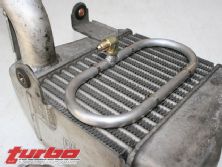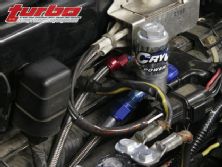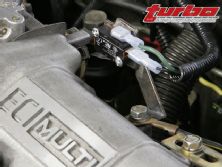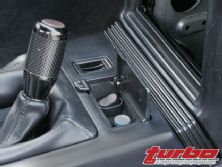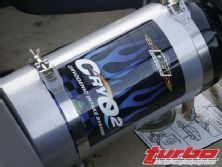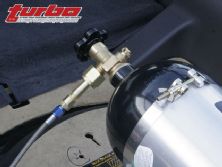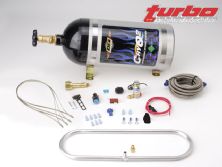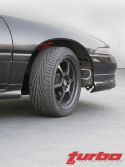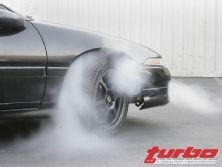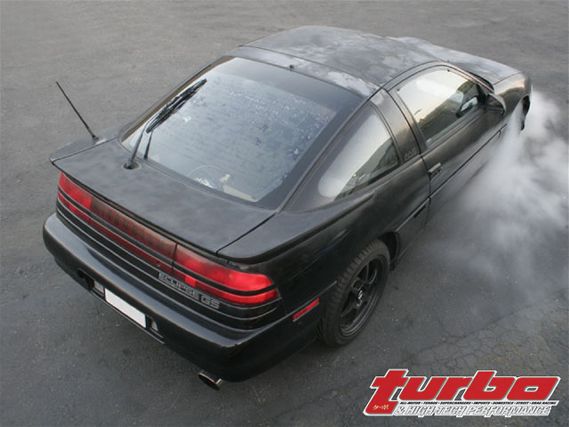 | Cooling The Intercooler - Garage.Tech
| Cooling The Intercooler - Garage.Tech
We probably should have found another car to test DEI's Cry02 Cryogenic Intercooler Sprayer on. Project Eclipse is finicky. Actually we're being a bit too kind; it's more of a two-steps-forward, one-step-backward kind of car. It seems as though every time we try and make something better, a couple of new yet unrelated problems make themselves known. We're hoping this just can't go on forever despite how much other 1G DSM owners seem to keep discouraging our optimism.
The logic for using our Eclipse to test the Cry02 system made sense at the time though, mostly because we're still using the factory-issued, side-mount intercooler and boosting a little more than one bar with our Big 16G turbocharger. We aren't experiencing any signs of detonation yet, but the measly, kid-sized intercooler core tucked behind the fenderwell could stand for some additional cooling off. Mitsubishi thought ahead and incorporated a fairly effective air duct into the front bumper, but a core this size, trapped behind plastic panels and sheetmetal, can only be so effective when generating such airflow. The fact is turbochargers create heat. When air is compressed, it heats up. The more it's compressed, the hotter things get. At 16 psi it puts us right in that hazy zone where we could get by with the side-mount but stepping up to a front-mount, or some alternative solution like methanol injection, would certainly yield gains.
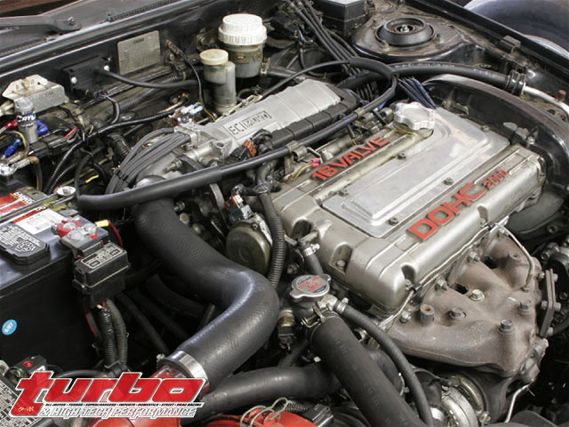 | Cooling The Intercooler - Garage.Tech
| Cooling The Intercooler - Garage.Tech
Intercoolers, like radiators, are heat exchangers. Saying something's a heat exchanger is just a fancy way of saying that two or more fluids are interacting with one another, exchanging temperature properties, but without actually touching. Their job is to remove heat from the intake charge by means of air- or water-cooling. The results make for a denser charge, resulting in more power and reduced chances of detonation. About the only downsides to intercooling are fitting the system in place and pressure drops as high as a few psi depending on the core's efficiency. We found a solution that gives all the benefits of a larger intercooler without the bad stuff.
We've heard the drill before; cool air makes horsepower and there are several ways to get such horsepower. DEI relies on the properties of carbon dioxide for temperature dropping. In geek-speak, carbon dioxide is the chemical bond between two oxygen atoms and one carbon atom. This means important things like photosynthesis for plants can occur, allowing us to do things like breathe and live; cooling down your intake charge is just an added benefit although one we arguably appreciate more. Carbon dioxide also takes on other forms, like dry ice when converted to a solid state. As a by-product of the combustion process, it's a relatively harmful greenhouse gas, unlike its chemical relative, carbon monoxide. Sizable power gains have been found from intake charge cooling; it's not uncommon to find 1 percent horsepower gains for every 10 degrees temperatures drop.
Carbon dioxide is a relatively smart gas to use for cooling applications like ours. It's cheap, it's non-flammable, and its relatively low-pressure gas-to-liquid transition phase allows more to fit inside a bottle than you might think. About the only thing you need to be aware of when spraying C02 around an engine bay is its non-combustible nature. C02 ingested into your air filter and introduced into the combustion process won't make for a happy engine. It's not really something detrimental, it'll just put a major damper on things we care about like the way combustion was meant to occur and decent cylinder pressure. Keeping the spray away from the filter will ensure the C02 actually helps more than it hurts. Project Eclipse kept finding ways to ingest C02 no matter what we did. We found giving the intercooler a good spray down prior to a full-throttle pass provided similar results without taking in C02 when it counted most.
Now is a good time to mention why a cooler intake charge is important and why some setups require extremely cold, ice-box-chilled liquid-to-air intercoolers and why some don't necessarily need an intercooler at all. Horsepower is dependent upon airflow. Airflow determines the extent that combustion will occur. Combustion requires a mixture of oxygen and fuel. The more oxygen you can stuff into a cylinder, the more fuel you can burn, which results in more power. That's because oxygen content determines the air's density-increased oxygen equals increased density. But it's not just about volume in terms of airflow. At sea level, the air around us contains roughly 21 percent oxygen-the stuff we care about. Sure, introducing more air into the engine can potentially increase power output, but altering the quality of the air, or its density, can do the same thing. One such example is nitrous oxide, a chemical that, when added to the combustion process, introduces additional oxygen to the mix. But this is only good during wide-open throttle conditions. Intercoolers, on the other hand, cool the intake charge as long as the engine's operating. We won't get into the different types of intercoolers or even the effectiveness of these different types but rather assume they're all there to do the same job-cool things down. As the intake charge is cooled, the oxygen molecules are packed closer together within the same space, meaning there's more there for combustion. The need for intercooling is proportional to factors such as engine compression, boost levels and compressor outlet temperatures. There are few cases, if any, where intercooling won't help, but that doesn't mean some cars can't get by without one.
DEI's developed a way to improve intercooler efficiency by as much as 50 percent by harnessing the power of carbon dioxide, thus dropping intake charge temperatures as much as 35 percent, but without having to bother fitting a larger core and plumbing in place or even having to cope with pressure losses. The Cry02 kit makes for a fairly brainless installation and, depending on whether or not you do a hack-job install, it could take you longer to go get the bottle filled than hooking everything up. The kit includes all of the important things like the 10-pound bottle, a solenoid, switches, hardware, steel-braided lines and the sprayer itself. If you've ever hooked up any sort of single-fogger nitrous kit, then it's likely you'll make quick work of the Cry02 kit. The solenoid, switches and wiring processes are eerily similar. DEI offers sprayers in three sizes, depending on what type of intercooler you're using. The sprayer mounts directly to the core and releases carbon dioxide via a wide-open throttle microswitch or momentary button.
The lesson: side-mount intercoolers aren't necessarily for sissies. Sure, they won't make you look as cool as you would with a front-mount crammed inside your chopped-up bumper, but with a little help and some creative chemistry they can be just as effective.

